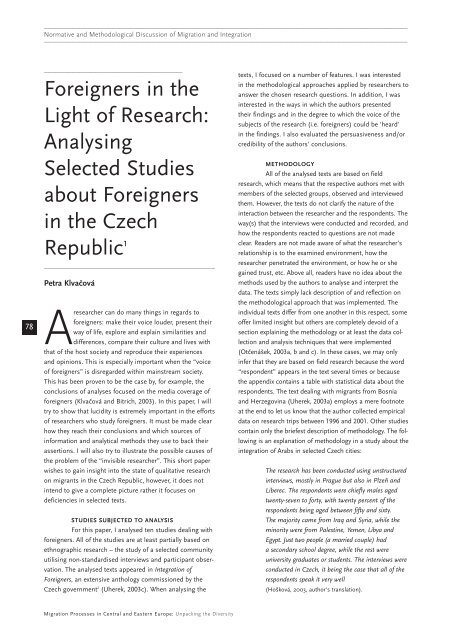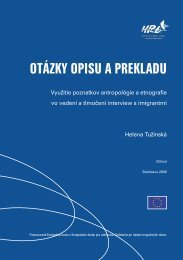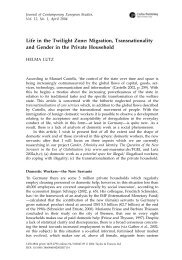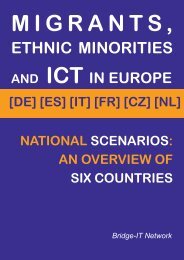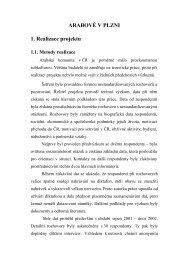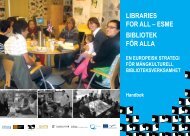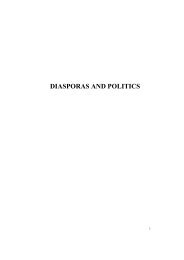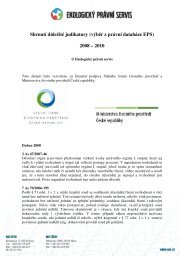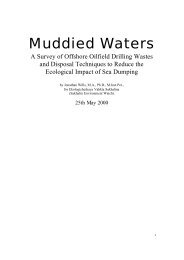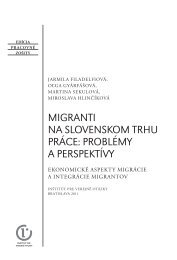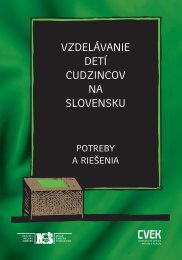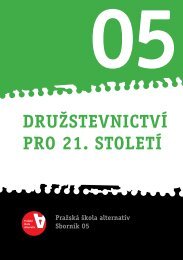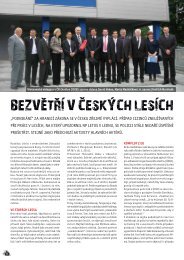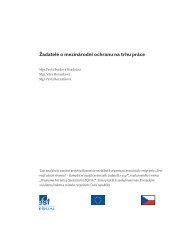Migration Processes in Central and Eastern Europe - Multiple Choices
Migration Processes in Central and Eastern Europe - Multiple Choices
Migration Processes in Central and Eastern Europe - Multiple Choices
You also want an ePaper? Increase the reach of your titles
YUMPU automatically turns print PDFs into web optimized ePapers that Google loves.
———————————————————————————————————————————————————————————————<br />
Normative <strong>and</strong> Methodological Discussion of <strong>Migration</strong> <strong>and</strong> Integration<br />
———————————————————————————————————————————————————————————————<br />
78<br />
————————————————————————<br />
Foreigners <strong>in</strong> the<br />
Light of Research:<br />
Analys<strong>in</strong>g<br />
Selected Studies<br />
about Foreigners<br />
<strong>in</strong> the Czech<br />
Republic 1<br />
—————————————————————————————<br />
Petra Klvačová<br />
Aresearcher can do many th<strong>in</strong>gs <strong>in</strong> regards to<br />
foreigners: make their voice louder, present their<br />
way of life, explore <strong>and</strong> expla<strong>in</strong> similarities <strong>and</strong><br />
differences, compare their culture <strong>and</strong> lives with<br />
that of the host society <strong>and</strong> reproduce their experiences<br />
<strong>and</strong> op<strong>in</strong>ions. This is especially important when the “voice<br />
of foreigners” is disregarded with<strong>in</strong> ma<strong>in</strong>stream society.<br />
This has been proven to be the case by, for example, the<br />
conclusions of analyses focused on the media coverage of<br />
foreigners (Klvačová <strong>and</strong> Bitrich, 2003). In this paper, I will<br />
try to show that lucidity is extremely important <strong>in</strong> the efforts<br />
of researchers who study foreigners. It must be made clear<br />
how they reach their conclusions <strong>and</strong> which sources of<br />
<strong>in</strong>formation <strong>and</strong> analytical methods they use to back their<br />
assertions. I will also try to illustrate the possible causes of<br />
the problem of the “<strong>in</strong>visible researcher”. This short paper<br />
wishes to ga<strong>in</strong> <strong>in</strong>sight <strong>in</strong>to the state of qualitative research<br />
on migrants <strong>in</strong> the Czech Republic, however, it does not<br />
<strong>in</strong>tend to give a complete picture rather it focuses on<br />
deficiencies <strong>in</strong> selected texts.<br />
STUDIES SUBJECTED TO ANALYSIS<br />
For this paper, I analysed ten studies deal<strong>in</strong>g with<br />
foreigners. All of the studies are at least partially based on<br />
ethnographic research – the study of a selected community<br />
utilis<strong>in</strong>g non-st<strong>and</strong>ardised <strong>in</strong>terviews <strong>and</strong> participant observation.<br />
The analysed texts appeared <strong>in</strong> Integration of<br />
Foreigners, an extensive anthology commissioned by the<br />
Czech government 2 (Uherek, 2003c). When analys<strong>in</strong>g the<br />
texts, I focused on a number of features. I was <strong>in</strong>terested<br />
<strong>in</strong> the methodological approaches applied by researchers to<br />
answer the chosen research questions. In addition, I was<br />
<strong>in</strong>terested <strong>in</strong> the ways <strong>in</strong> which the authors presented<br />
their f<strong>in</strong>d<strong>in</strong>gs <strong>and</strong> <strong>in</strong> the degree to which the voice of the<br />
subjects of the research (i.e. foreigners) could be 'heard'<br />
<strong>in</strong> the f<strong>in</strong>d<strong>in</strong>gs. I also evaluated the persuasiveness <strong>and</strong>/or<br />
credibility of the authors' conclusions.<br />
METHODOLOGY<br />
All of the analysed texts are based on field<br />
research, which means that the respective authors met with<br />
members of the selected groups, observed <strong>and</strong> <strong>in</strong>terviewed<br />
them. However, the texts do not clarify the nature of the<br />
<strong>in</strong>teraction between the researcher <strong>and</strong> the respondents. The<br />
way(s) that the <strong>in</strong>terviews were conducted <strong>and</strong> recorded, <strong>and</strong><br />
how the respondents reacted to questions are not made<br />
clear. Readers are not made aware of what the researcher's<br />
relationship is to the exam<strong>in</strong>ed environment, how the<br />
researcher penetrated the environment, or how he or she<br />
ga<strong>in</strong>ed trust, etc. Above all, readers have no idea about the<br />
methods used by the authors to analyse <strong>and</strong> <strong>in</strong>terpret the<br />
data. The texts simply lack description of <strong>and</strong> reflection on<br />
the methodological approach that was implemented. The<br />
<strong>in</strong>dividual texts differ from one another <strong>in</strong> this respect, some<br />
offer limited <strong>in</strong>sight but others are completely devoid of a<br />
section expla<strong>in</strong><strong>in</strong>g the methodology or at least the data collection<br />
<strong>and</strong> analysis techniques that were implemented<br />
(Otčenášek, 2003a, b <strong>and</strong> c). In these cases, we may only<br />
<strong>in</strong>fer that they are based on field research because the word<br />
“respondent” appears <strong>in</strong> the text several times or because<br />
the appendix conta<strong>in</strong>s a table with statistical data about the<br />
respondents. The text deal<strong>in</strong>g with migrants from Bosnia<br />
<strong>and</strong> Herzegov<strong>in</strong>a (Uherek, 2003a) employs a mere footnote<br />
at the end to let us know that the author collected empirical<br />
data on research trips between 1996 <strong>and</strong> 2001. Other studies<br />
conta<strong>in</strong> only the briefest description of methodology. The follow<strong>in</strong>g<br />
is an explanation of methodology <strong>in</strong> a study about the<br />
<strong>in</strong>tegration of Arabs <strong>in</strong> selected Czech cities:<br />
The research has been conducted us<strong>in</strong>g unstructured<br />
<strong>in</strong>terviews, mostly <strong>in</strong> Prague but also <strong>in</strong> Plzeň <strong>and</strong><br />
Liberec. The respondents were chiefly males aged<br />
twenty-seven to forty, with twenty percent of the<br />
respondents be<strong>in</strong>g aged between fifty <strong>and</strong> sixty.<br />
The majority came from Iraq <strong>and</strong> Syria, while the<br />
m<strong>in</strong>ority were from Palest<strong>in</strong>e, Yemen, Libya <strong>and</strong><br />
Egypt. Just two people (a married couple) had<br />
a secondary school degree, while the rest were<br />
university graduates or students. The <strong>in</strong>terviews were<br />
conducted <strong>in</strong> Czech, it be<strong>in</strong>g the case that all of the<br />
respondents speak it very well<br />
(Hošková, 2003, author's translation).<br />
<strong>Migration</strong> <strong>Processes</strong> <strong>in</strong> <strong>Central</strong> <strong>and</strong> <strong>Eastern</strong> <strong>Europe</strong>: Unpack<strong>in</strong>g the Diversity


